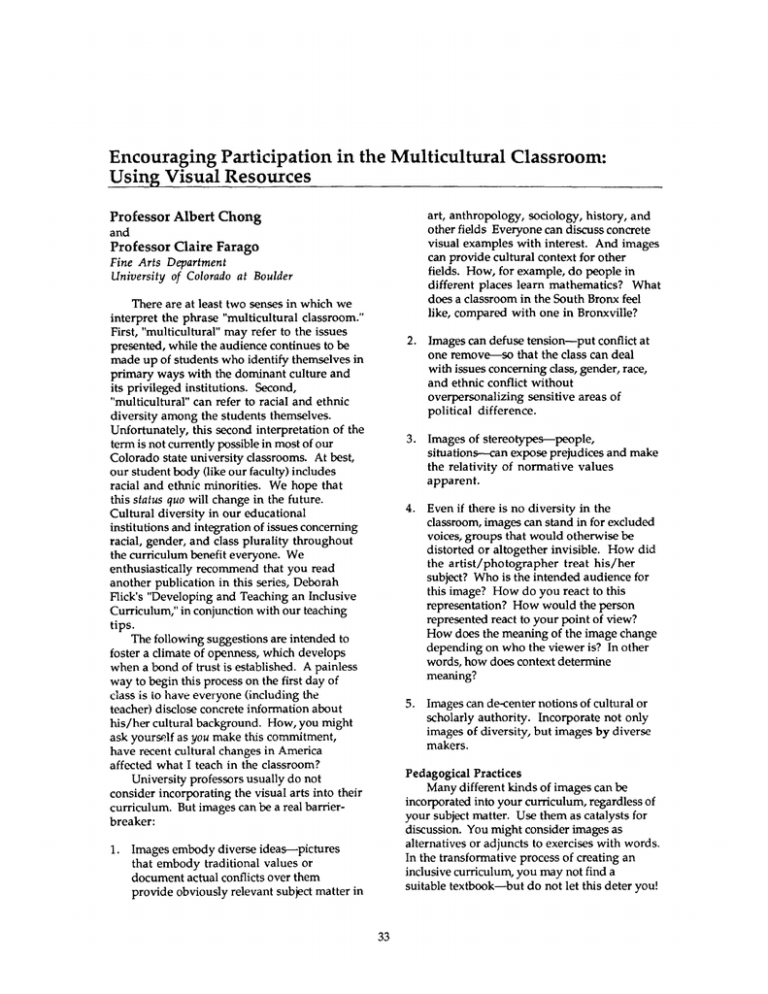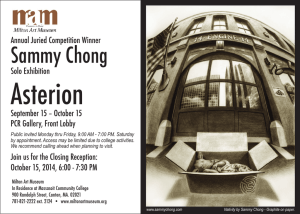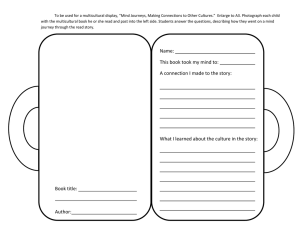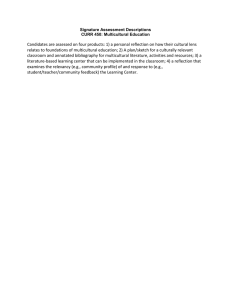Encouraging Participation in the Multicultural Classroom: Using
advertisement

Encouraging Participation in the Multicultural Classroom: Using Visual Resources Professor Albert Chong and Professor Claire Farago Fine Arts Department University of Colorado at Boulder There are at least two senses in which we interpret the phrase "multicultural classroom." First, "multicultural" may refer to the issues presented, while the audience continues to be made up of students who identify themselves in primary ways with the dominant culture and its privileged institutions. Second, "multicultural" can refer to racial and ethnic diversity among the students themselves. Unfortunately, this second interpretation of the term is not currently possible in most of our Colorado state university classrooms. At best, our student body (like our faculty) includes racial and ethnic minorities. We hope that this status quo will change in the future. Cultural diversity in our educational institutions and integration of issues concerning racial, gender, and class plurality throughout the curriculum benefit everyone. We enthusiastically recommend that you read another publication in this series, Deborah Flick's "Developing and Teaching an Inclusive Curriculum," in conjunction with our teaching tips. The following suggestions are intended to foster a climate of openness, which develops when a bond of trust is established. A painless way to begin this process on the first day of class is to have everyone (including the teacher) disclose concrete information about his/her cultural background. How, you might ask yourself as you make this csraunitment, have recent cultural changes in America affected what I teach in the classroom? University professors usually do not consider incorporating the visual arts into their cumculum. But images can be a real bamerbreaker: 1. Images embody diverse ideas-pictures that embody traditional values or document actual conflicts over them provide obviously relevant subject matter in art, anthropology, sociology, history, and other fields Everyone can discuss concrete visual examples with interest. And images can provide cultural context for other fields. How, for example, do people in different places learn mathematics? What does a classroom in the South Bronx feel like, compared with one in Bronxville? 2. Images can defuse tension-put conflict at one remove-so that the class can deal with issues concerning class, gender, race, and ethnic conflict without overpersonalizing sensitive areas of political difference. 3. Images of stereotypes-people, situations-can expose prejudices and make the relativity of normative values apparent. 4. Even if there is no diversity in the classroom, images can stand in for excluded voices, groups that would otherwise be distorted or altogether invisible. How did the artist/photographer treat his/her subject? Who is the intended audience for this image? How do you react to this representation? How would the person represented react to your point of view? How does the meaning of the image change depending on who the viewer is? In other words, how does context determine meaning? 5. Images can de-center notions of cultural or scholarly authority. Incorporate not only images of diversity, but images by diverse makers. Pedagogical Practices Many different kinds of images can be incorporated into your cumculum, regardless of your subject matter. Use them as catalysts for discussion. You might consider images as alternatives or adjuncts to exercises with words. In the transformative process of creating an inclusive curriculum, you may not find a suitable textbook--but do not let this deter you! Images can help you structure the course around diverse readings instead of a text. Is there a book illustrated with art that you absolutely love, that you would consider sharing with your students? Is there a book in the media that has generated controversy, e.g. Madonna's sex book, or Salman Rushdie's Satanic Verses? Bring it in and let them thumb through or read selected passages. Sources for images are provided at the end of this brochure. Use images to address concerns relevant to the students' actuaI cultural backgrounds. Events current in the media provide concrete situations and alleviate selfconsciousness. Consider discussing recent race-related violations of individual civil rights and their subsequent impact on individuals and their communities; current affairs as they affect the rights and survival of culturally marginalized peoples; issues such as Amendment 2, sexual orientation, gay and lesbian rights; women's rights, the abortion debate, and the right of individuals to govern their own bodies; the rights of individuals to cause their own death or assist in the death of others who may be terminally ill or in constant physical pain. These topics range from birth to death; the common thread that joins them is the rights of the individual or group living in societies that limit and in some cases completely disregard individxal freedom. Do not make any individuals feel responsible for the ills of society. NEVER allow any individual or group in the classroom to serve as the object of the critique. Use studentcentered teaching techniques. Your students can make and collect images as well as discuss the ones you bring to class. You can incorporate visual art into your multicultural curriculum painlessly by devising ways in which images could clarify and enrich the issues and information you want to teach, then letting students implement your ideas. Have your students bring in a picture of a stereotype from the media, and let them describe it or imagine its opposite, or analyze what its intended message is, how the audience is supposed to respond to it, who the audience is, who it isn't. And one year's harvest can become the next year's seed. Good teachers do not rely on formulas; instead, they funnel experience through the individual. The difference between teaching techniques and communicating ideas is like the difference between knowing how to use a camera and making a picture. Developing a One-World Point of View Multiculturalism slips and slides liberally from the lips of the politically correct, who often espouse it only in the context of race, ignoring its application to differences in sexual or religious orientation, gender, or class. The true multicultural classroom must embrace a philosophical support for cultural pluralism that is reflected in the syllabus of the instructor and the curriculum of the institution. To cite an example in the Department of Fine Arts, from which we hail, art history, which historically has been eurocentered, now is taught so that Europe is not elevated above Africa, even though the bulk of our information, our teaching materials, and our own education is eurocentered. In the studio arts it is also important for the instructor to be abreast of intellectual trends in contemporary culture. We must include not only works from the hyphenated cultures of America and of the world but also works that challenge existing paradigms and that constantly ask the student to reevaluate his or her position about art and culture. We must establish an understanding that "minority" cultures too are not fixed or static, but are constantly reinventing themselves to fit changing times, taking with them the baggage of a history of struggle for recognition from a white cultural hegemonic elite. Recruitment and retention of students and faculty of color continues to be a major problem within this institution. True multiculturalism, devoid of the lip service that has pervaded so much of academia and the progressive communities within American society, is based on the inclusion of diverse points of view, first in the forming of our own personal world view, and then among our families, friends, and, most importantly, our students. A balanced curriculum should contain a reading list of scholars, research scientists, artists, writers, curators, and critics who are clearly outside the mainstream of our disciplines. The present infrastrvcture of our society incarcerates more non-white people than it educates. It costs more per year to imprison people than it does to educate them. In order for the multicultural classroom to exist, our children must have access to good elementary, undergraduate, and graduate education--good meaning education free from the cultural biases currently embedded within the educational system. Students of color must feel welcome within these institutions, and the curriculum must at some point in their school career be relevant to their respective cultures. See Further... Academic Media Services can supply a list of mediaquipped classrooms of all sizes. You may also rent or make videos, rent equipment, and buy services-even get some (like slides made to order) free. For a one-time nominal $5 fee, you can check out slides from the Department of Fine Arts Slide Library: call 492-6136 for information. The adventurous can use three permanent facilities with rotating art exhibitions right on campus: Sibell-Wolle Gallery of the Department of Fine Arts (for information, call 492-8003), the University Museum, with excellent permanent collections of Native American and other arts (492-6892), and the art galleries in the University Memorial Center, second floor (492-7465). Also available to professors who are interested in incorporating images, photographs, or rare books into their curriculum is the rare books room of the Art and Architecture Library, which contains a special collection of books on and about photography. Many intriguing and thought-provoking photographic portfolios can also be viewed here, and viewing pictures can be a stimulating diversion in a business-asusual semester. Another opportunity to introduce diverse points of view into a teaching curriculum via art and images is to either assign or accompany your class to attend the Visiting Artist Program lecture series in the Department of Fine Arts. The program features the most innovative and diverse artists in all fields of art making, theory, and criticism. Lecturers are on alternate Tuesdays at 8:00 p.m. in room N141 in the Fine Arts Building. To check the schedule and information on the artists, call the Department of Fine Arts at 492-6504. Videotapes of past lectures are available. Useful Reading Clifford, James. The Predicament of Culture: Twen tieth-Century Ethnography, Literature, and Art. Cambridge (MA)London: Harvard University Press, 1988. Exhibiting Cultures: The Poetics and Politics of Museum Display. Ed. Ivan Karp and Steven D. Lavine. Washington-London: Smithsonian Institute Press, 1991. Flick, Deborah. "Developing and Teaching an Inclusive Curriculum." On Diversity in Teaching and h r n i n g , no. 2. Faculty Teaching Excellence Program, University of Colorado at Boulder. Hooks, Bell. YEARNING, Race, Gender, and Cultural Politics. Boston: South End Press, 1990. Image of the Black in Western Art, foreword by Amadadou-Mahtor M'Bow, 4 Volumes. New York: Marrow, 1976. Lippard, Lucy. Mixed Blessings: New Art in a Mu1ticultural America. New York: Pantheon Books, 1990. Preziosi, Donald. Rethinking Art History: Meditations on a Coy Science. New HavenLondon: Yale University Press, 1989. Reed, Hsrnael. Writin' is Fightin'. New York: Atheneum, 1988. Torgovnick, Marianna. Gone Primitive: Savage Intellects, Modern Lives. Chicago-London: University of Chicago Press, 1990. Walker, Alice. The Temple of My Familiar. New York: Harcourt, Brace, Jovanovich, 1989. Claire Farago Biography Claire Farago's field of specialization is Italian Renaissance art theory. She has published a book and numerous articles on Leonardo da Vinci's comparisons of the arts and related issues. About four years ago, she began working on the changing status of the arts viewed in a crosscultural framework: how, she initially wanted to know, did the importation of non-European objects and the exportation of Renaissance humanist values contribute to later notions of the hierarchy of the visual arts? How are the cultural boundaries put in place in the early modem period still part of our contemporary assumptions about the role of art in society? Claire is currently working on three book projects, several related articles, and classroom teaching that grows out of these interests. Out of her long-standing study of Renaissance texts, she is collaborating with an international team of scholars under the general editorship of Martin Kemp to produce a modem critical edition of Leonardo da Vinci's "Treatise on Painting," which laid the foundation for academic training of artists and has been widely read for four centuries. Second, Clare is writing an essay style book entitled "Art as Institution: 'Race,' Nation, and the Writing of Art History." This project grows out of the realization that the professionalization of the discipline of art history in the nineteenthcentury has never yet been viewed in the context of discussions of cultural evolutionism at the time. The hierarchy of painting, sculpture, and architecture defined in European terms is as much a product of those events during the age of emerging nationalism as it is a product of sixteenthcentury cultural exchange. Her study treats both periods, together with discussion of current critical issues concerning the power of images. Third, Claire is writing a book and producing with her students an accompanying exhibition on southwestern devotional art, known as santos. This project, provisionally entitled "Living in Two Worlds: The Power of the People. The sacred practice of daily life in the American Southwest, 1800-1995," looks at the ethnic complexity of the visual culture that developed in this region. Her study examines current models of hybrid culture in light of the visual evidence, taking into account her own position as a scholar working in a historical continuum. It is unlike previous studies in that it does not compartmentalize Spanish versus Native versus other ethnic groups on a nineteenth-century model of national culture: instead it examines the hybrid cultural products that emerged over the course of two centuries of colonial and post colonial contact. She and her students are especially careful NOT to reveal the visions of people who intentionally exclude outsiders: instead they examine the circumstances that led to such measures of secrecy in the first place. Albert Chong Biography Born in Kingston, Jamaica on November 20, 1958 of African and Chinese ancestry. Albert Chong is the last of nine children of merchant parents. He left Jamaica in 1977 to permanently reside in the United States. He attended the School of Visual Arts in New York from 1978-1981 graduating with honors. Chong's exhibiting career started in 1981, and in that year his son Ayinde was born. He has a daughter as well, Chinwe born in 1987 and he is married to Frances Charteris also an artist. Chong taught at the School of Visual Arts, in New York from 1986-1988, and at Mira Costa College in Oceanside, California from 1989-91. In 1988 Chong, Charteris and family moved to San Diego where he attended the University of California, San Diego. In 1991 he was awarded the Master of Fine Arts degree from UCSD,and in that year as well he accepted a faculty appointment in the Department of Fine Arts at the University of Colorado at Boulder. Albert Chong's photographs are in included collections both public and private, national and international. The three main bodies of his photographic work include the I-Trait series, The Still life's, and the Thrones for the Ancestors. Other aspects of his work include mixed media sculptural installations, book works and fabricated to be photographed objects. His works have been widely exhibited nationally. Recent venues exhibiting his work include the Ansel A d a m Center for photography in San Francisco, Sangre De Christo Arts Center in Pueblo, Colorado. LJpcomingvenues include the Cleveland Museum of Art, and the Havana Bienal in Cuba. He is the recipient of several artist fellowships, including a 1994 CO Visions Recognition award from the Colorado Council on the Arts, a regional National Endowment for the Arts Fellowship in Photography, and a 1992 National Endowment for the Arts Fellowship in Photography. His work is represented by Porter Randall Gallery in La Jolla, California, Catherine Edelman Gallery in Chicago and Carla Stellweg Latin American & Contemporary Art Gallery in New York. Chong's work has been the subjtxt of numerous essays articles and reviews in daily publications such as the New York and LA Times and in art periodicals and books. A book of his photographs has been published by the friends of Photography in San Francisco and is titled Ancestral Dialogues: The Photographs of Albert Chong.



